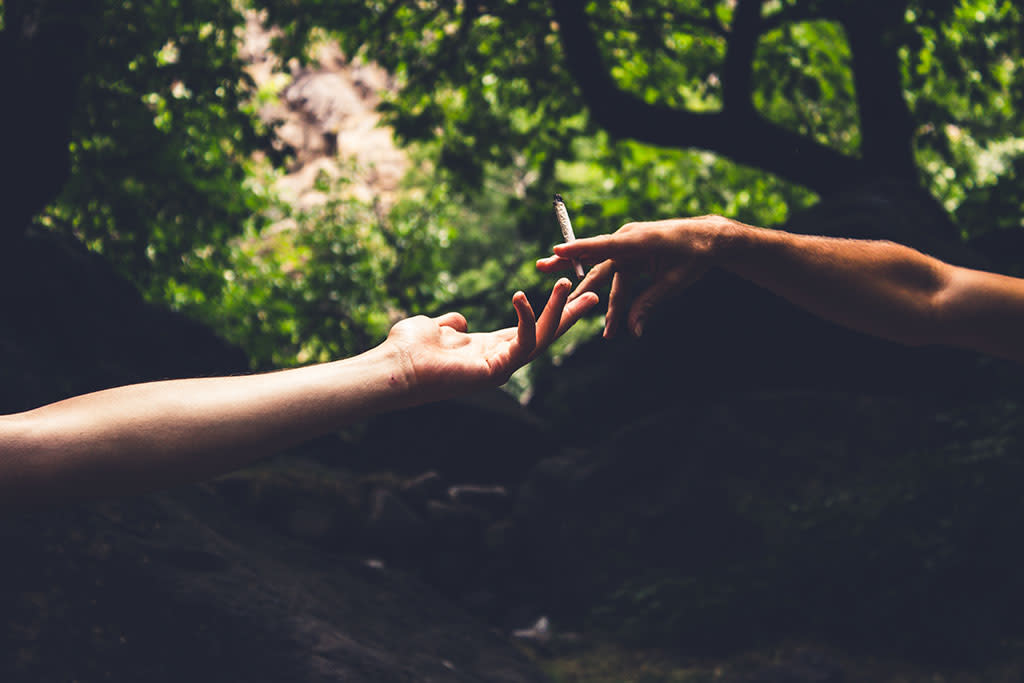Inviting Mary Jane to Your Yoga Practice

The first few times I consumed cannabis were so unremarkable that I can’t recall them, but my third experience was a doozy. I was fifteen, in high school, adventurous, and ready for my long-promised adulthood. I can still see it: My boyfriend standing in the kitchen, his stringy black hair hanging down in his face, intently heating butter knives to red-hot on the stovetop. When they were ready, he dropped a huge plop of hash onto each of the knives, and then showed me how to sip the thick smoke through a funnel we’d fashioned from a half-gallon pop bottle.
Inhale. It doesn’t feel that rebellious, really. After all, Mom smokes weed. Hold. Ouch, this burns. Exhale. Immediately the room is spinning, I can’t breathe, and my heartbeat is pounding in my head. I flail about, a fish out of water, knocking over the coffee table. The room closes in around me. I’m tripping balls. Panic attack.
As a kid, I believed everything. D.A.R.E. (Drug Abuse Resistance Education) taught me about the evils of marijuana. I knew my mom did “drugs” in the back room; I could smell the skunky smoke and requisite Lysol each time and see the butts in the ashtrays after parties.
My aunt and grandmother did not do drugs, and I could tell they thought my mom should not either; their hints and indirect negative remarks were not lost on me. For my part, I was just worried about her, because I didn’t want her brain to be fried like the eggs in the frying pan on TV.
One day in the sixth grade the police came to my school and showed us dirty bongs made of pop bottles, warning us about criminals who might offer them to us. I secretly died of embarrassment, certain mine was the only mother who had such paraphernalia at home. At a slumber party a year later, my friends found a baggie in my mom’s bedroom. I vehemently denied it was “dope,” even though they all knew it was. My plausible deniability was shattered after that, and I couldn’t pretend Mom wasn’t a druggie, a criminal, an outlaw. In protest, I refused to wash her dirty ashtrays.

It’s no wonder, then, with visions of vicious criminals and brain cells cooking at a high temperature, that I struggled with anxiety when I did smoke. In addition to the anxiety, every time I got high after that, the intense sensation of panic would come back, a symptom of PTSD. I’d project negative meaning onto everything anyone said, or, weirder, I’d have the overwhelming sense that I could hear people’s thoughts or “know” that they were reading mine. And it was always negative. I spent many nights at teenage parties bawling my eyes out, trying to just be normal and get high like everyone else.
AFTER A WHILE, I GAVE UP TRYING, ASSUMING I MUST HAVE AN ALLERGY TO WEED. I VIEWED CANNABIS THE WAY I DID BOOZE: A DRUG THAT IS FINE FOR MY MOM AND FRIENDS - AND EVEN MY FRIENDS WHO WERE NOW PUFFING WITH MOM! - BUT NOT FOR ME.
The irony is not lost on me that I had such a negative experience with the plant early on, and now I am one of the leaders in the cannabis wellness movement. Much of my life consists of talking about how cannabis enhances my mind-body connection when I do yoga. When I think about how intense and awful that experience with weed was in my teens in light of my career, it’s like talking about two different drugs.
Twelve years later when I bravely tried cannabis again, I actively strove to overcome the paranoia and dissociative states. If I microdosed, I could mitigate most of the anxiety, and getting stoned was fun. By then I had practiced a lot of yoga while sober, giving me the tools to deal with hard stuff that came up. I was older, more psychologically mature, more knowledgeable about the plant, and, not to be overlooked, not overdosing with a bunch of sweaty teenage boys.
My relationship with yoga was far less traumatic. Slow, mindful yoga had helped me through a bout of depression in my teens, had given solace to my feelings of isolation and loneliness at college, and had soothed my nerves as I went through breakups in my twenties. I even brought it with me when I taught English in South Korea for two years. It’s my longest-lasting friendship.
So when I developed a healthy relationship with weed—finally—the first thing I noticed is that it made yoga, like sex and music, far better.

I could quiet my mind in ways I had never before been able to do, despite my many years on the mat. Pot lifted a veil of mental fog that I didn’t even know existed. It’s a little like the years I’d spent thinking my digestion issues were normal, until a friend (correctly) suggested maybe I was lactose intolerant. When I cut out dairy, my bloating disappeared and my definition of “normal” totally changed.
With the addition of ganja, my definition of “yoga” would never be the same. I could get to bliss and clarity in my meditations far faster and deeper than when sober. The mental chatter slowed down, and I could more easily connect with the profound space and silence inside.
Plus, I could finally feel the esoteric aspects of yoga that I’d been reading about for years, things like chakras, which in yoga are seven “vortexes of energy” that run along the spine and have a coordinating color and psychological association. Being a smarty-pants, I’ve always valued the rational mind and didn’t believe in anything that couldn’t be proven by science. Meditating on my heart, throat, or third eye when doing yoga sober rarely felt any different from focusing on the palm of my hand, lip, or any other nonchakra part. After I enhanced yoga with cannabis, however, the subtle yet not-so-subtle pulse of aliveness in these “energy centers” could not be denied, despite my rational academic mind’s disbelief in them.
NOT ONLY DID I FEEL CHAKRAS WHEN I DID STONED YOGA, I FOUND MYSELF EXPERIENCING ORGASMIC BLISS FROM THEM! SPIRALS OF CASCADING PLEASURE AND DELIGHT WITH NO BEGINNING AND NO END. YUM!
Needless to say, these fruitful experiments propelled me to start blending cannabis and yoga practice regularly. This was before major news outlets were publishing front-page stories about the medical benefits of weed. It was also before I knew yogis in India had been elevating the practice for millennia. I just know it worked for me, which is surprising because I was twenty-seven and had been doing yoga since I was fifteen. As I said, I was a late bloomer.

Despite still having to grapple with paranoia at times, I found that pot brought unmistakable insight to my life and yoga practice. I learned to work with my cannabis-fueled anxiety, realizing that the plant had been magnifying some of the thoughts and feelings I had not been allowing myself to express, negative emotional stuff that had been bottled up for years, even decades.
Weed-fueled yoga made the high feel psychologically and spiritually therapeutic, like the way peyote and ayahuasca might work. Journeys into some of the darker parts of the self can sometimes be painful, but with my twelve-year yoga practice now enhanced with cannabis, I could tap into and heal things I hadn’t before been able to access. While doing yoga.
I also loved how pot helped me tune into my body and connect to the stretching muscles. It wasn’t all shamanic voyaging into darkness. In fact, it was mostly just awesome stoner trippin’ and feeling groovy.
A year later, I went from fighting paranoia most of the time I got high to less than half the time. I’m a lot of things, and tenacious is one of them.
As I mastered dose and setting and brought light to my unconscious fears so they had less power, I soon started toking more often, one to three times a week. It was still very tentative. I did so only in situations where I could feel safe, be warm enough, have water handy, and be around people I was fully comfortable with. My pasties (mouth dryness), my munchies, my sense of time shifting, all the stoner stereotypes were superstrong for me then, and I was very protective of my high, especially knowing how awful it was when it slid into a bad trip.
As I got more into the ganja, I switched gears professionally. I went from working on a graduate degree in human sexuality to a five-hundred-hour yoga teacher training program. The training program was the most relaxing, “spiritual” one I could find, and it felt right for me. Later I found out it was based on Tantra Yoga and emphasized the mystical aspects of the tradition.

I developed a close relationship with my teacher, Ananda Shakti, a white woman who wears colorful Indian saris and a bindu, or ornamental dot, at her third eye (located in the middle of the forehead). Midway through the training I asked her her opinion about combining cannabis and spiritual practice.
She said sometimes regular pot use can “open unhealthy energy channels,” but otherwise we each make our own path to finding oneness with all. She herself practiced without enhancements or sacraments and didn’t even consume wine with dinner. But because she was not demanding that I live her life or treat her as a guru to be emulated, I got her indirect blessing for my enhanced yoga leanings, promising to keep her concern about the “additional energy channels” (which I only felt when high on pot anyway) most certainly in mind.
I can’t be sure, but according to Google I was the first Westerner to offer yoga classes where people enhance. Ganja Yoga started as a monthly class in Toronto in 2009 in my living room. Today, eight years later, I teach two popular weekly classes and have a thriving private practice in San Francisco, where I (stereotypically?) moved.
I’ve taught a variety of people, including a movie star, and in a variety of different places, including on the beach in Costa Rica and at Burning Man. Other teachers in Juneau, Denver, Seattle, Honolulu, LA, and Vancouver have been inspired to offer their own version of enhanced yoga. Ganja Yoga has been covered in the New York Times and in news outlets from Europe to India. One day, one of the biggest and most respected publishers in the world knocked on my door (okay, sent me an e-mail). And now we have the book you hold in your hands.
I could have never foreseen what Ganja Yoga has become. It has exploded from its humble beginnings in my living room to a worldwide phenomenon, rising alongside and as a result of daily news reports on the health benefits of cannabis and the lightning-fast move toward legalization. It’s a breathtaking, trippy fairy tale.
Look at me, Mom. Pretty good for a poor girl from rural Ontario.
If you have picked up my book, it means you’re a part of my fairy tale now, and if I have done my job, I’ll be a part of yours.
Some of you will be new to either yoga or cannabis or both. No matter where you’re coming from, my philosophy is that Ganja Yoga be an expression of the accepting, easygoing attitudes stemming from both yoga and weed. Even if you’re a newbie, it’s all good, man.

In the pages of my book you’ll find everything you need to know for safe, relaxing experiences with weed, yoga, and the two combined. If you’re already a cannabis user, whether a seasoned daily stoner or occasional toker, I hope you’ll be inspired to try yoga, and especially stoned yoga. If you already practice yoga, I’d love to inspire you to try a slower, easier, more mindful practice than what’s usually thought of as “yoga” and to introduce you to the wellness benefits of the complex and miraculous plant that is cannabis!
As the pioneer of this movement, I want to emphasize that Ganja Yoga is yoga for all bodies; it is able to work to some degree for anyone. If you’re not sure you can do it, know that I’ve taught it to an eighty-year- old MS patient in a wheelchair, a man recovering from a ten-year coma, veterans, several abundant-bodied folks, and many inflexible people who claimed they couldn’t “do yoga.”
Cannabis-enhanced yoga (and really all yoga) is not about accomplishing poses; it is about feeling our bodies and becoming more relaxed and present. People who have felt excluded from the challenging world of modern yoga appreciate this, as do fit, healthy people who are looking for a more mindful, meditative practice than what is offered in most mainstream studios.
Printed from GANJA YOGA: A Practical Guide to Conscious Relaxation, Soothing Pain Relief, and Enlightened Self-Discovery Copyright 2017 By Dee Dussault. Reprinted with permission by HarperOne, a division of HarperCollinsPublishers.

 First, create your Sava account.
First, create your Sava account. Your $40 discount will apply automatically on your first order.
Your $40 discount will apply automatically on your first order.